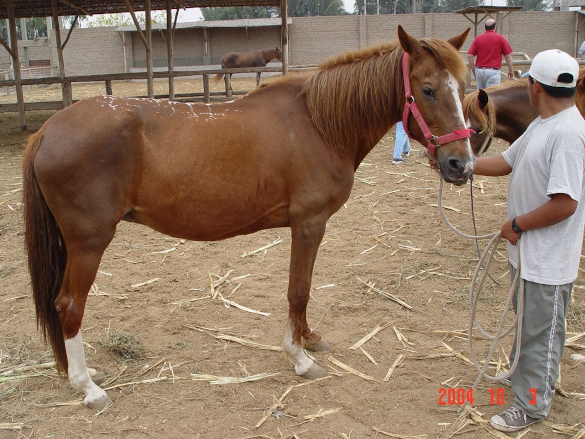Want to join me in making a difference? I'm raising money to benefit horses, and any donation will help make an impact. We desperately need a diagnostic assay for a horse disorder which destroys leg tendons and other tissues. My laboratory has been working on this destructive and puzzling disorder affecting many breeds of horses. It is called degenerative suspensory ligament desmitis or DSLD for short.
You do not have to own horses to love these graceful beautiful creatures. They communicate with their eyes and gentle movements, and when they suffer, you can tell from their expression. And many of them do suffer, especially those horses afflicted with DSLD of certain ligaments (and tendons) in their lower legs.
As you can see on the photo the fetlock drops – in some cases to the ground, and stays like this. That becomes quite painful, and horses become lame, unable to move around. Because of the unrelenting pain (and no available treatment), many horses end up being euthanized, much to distress of their owners.

It was our lab in the College of Veterinary Medicine that discovered that this is a systemic disease affecting mostly tendons and ligaments, but also other organs, such as aorta, sclerae in the eye and even skin. We have some idea what damages the tissues – accumulation of so called proteoglycans disrupts normal architecture and weakens tendons and ligaments in the legs as one of the main problems. So far no genetic defect or mutation has been discovered (though DSLD tends to run in families) and there is no good diagnostic assay or treatment available. We have found that certain genes are highly expressed in the skin of horses with DSLD. Our goal is to develop a diagnostic assay which would identify horses with DSLD or horses who are likely to get DSLD in the future – right now we have no idea to identify such animals. To develop this assay we will ask horse owners and veterinarians to send us a small piece of skin from the horse’s neck so we can test these samples for the presence of certain compounds. We will have to test a lot of healthy and DSLD-affected horses.
Thanks in advance for your contribution to this cause that means so much not only to me, but to many horse lovers and veterinarians, and in the end to horses – which is the most important thing!!